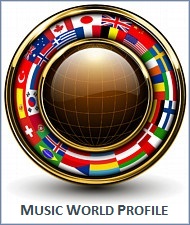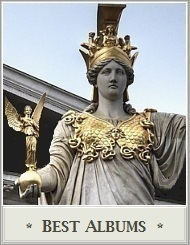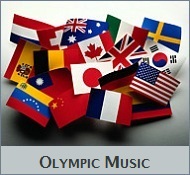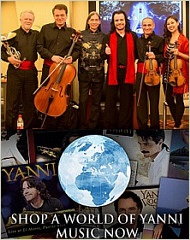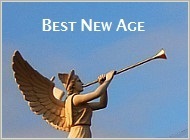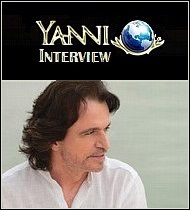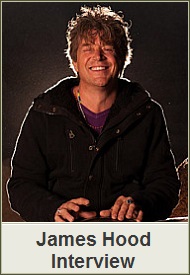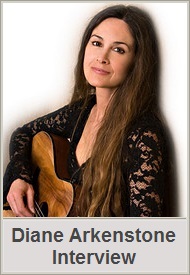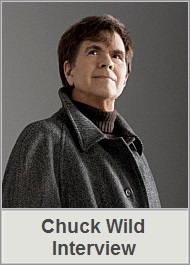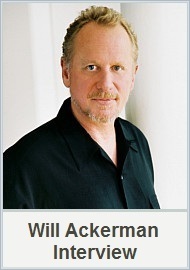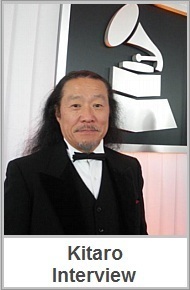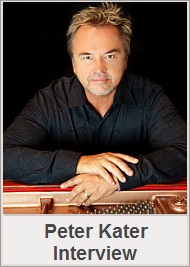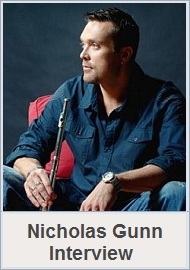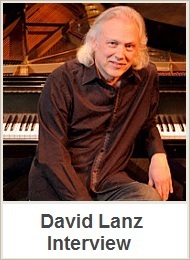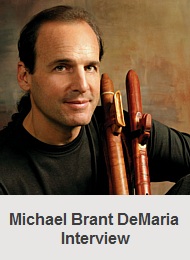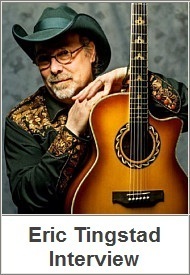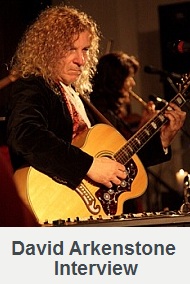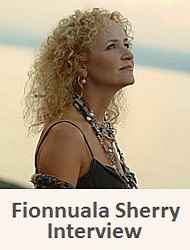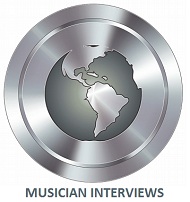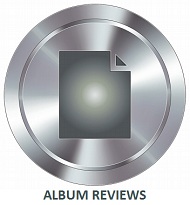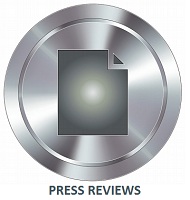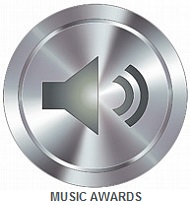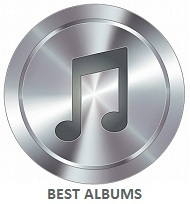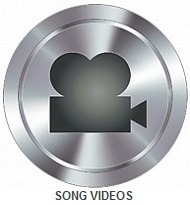Archive for the ‘Flute’ Category

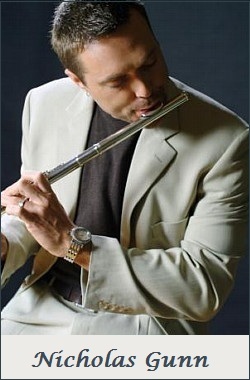 Nicholas Gunn Interview – Special News in 2013 and Forward:
Nicholas Gunn Interview – Special News in 2013 and Forward:
Multi-platinum recording artist Nicholas Gunn is a classically trained flutist recognized as one of the best-selling instrumental flutists worldwide.
Famous for the contemporary atmosphere and resounding beauty of his music, Nicholas Gunn has achieved earlier success of over 2 million albums sold, having become a legendary artist in the instrumental music industry, with many of his albums reaching the Top 10 Billboard Charts.
Nicholas Gunn’s newest instrumental release for 2012, and perhaps most significant of all is his fourteenth album named Thirty-One Nights, which arrives after an interval of 5 years. The highest standards we have come to expect are expertly portrayed on Thirty-One Nights, which enlists the world-class talents of vocalist Dana Kemmerle, along with acoustic guitarist Chris Fossek.
New Age Music World host John P. Olsen had an opportunity to interview Nicholas Gunn months prior to 2013. During the newest interview with Nicholas Gunn the range of topic include a conversation about his new album, history and career as an artist, National Park albums, and the Gemini Sun Records Label he once owned and operated.
Nicholas Gunn also states his views on today’s music industry and the upcoming Ballots and Nominations for the 55th GRAMMY® Awards. And perhaps most importantly, Nicholas Gunn has released a significant news announcement regarding his music career going forward. Today we are pleased to present their conversation to fans, and to Music World site visitors.
John P. Olsen: Thank you for accepting my interview invitation Nicholas. It is a privilege to host your newest interview in 2012, here at New Age Music World. I have been a huge fan of your music for many years, plus I enjoyed reading even more about you while preparing for our interview together. I must say you have experienced a fascinating life and career Nicholas.
Nicholas Gunn: Thank you John, it is really a pleasure to be a part of your music forum today, and it’s great to see how popular New Age Music World has become.
John: Thanks for your compliment! Let me begin with your earliest experiences as a musician, since your educational studies seem to have been a formative influence in the music you produce today. You were born in South East England, and were academically trained from age 7 to 11 in classical music at the Royal Academy of Music conservatoire in the UK. While attending the Royal Academy of Music, what led you to choose woodwinds over other instruments, and would you please tell us about your earliest academic studies, training and first introduction to music while living in the UK?
 Nicholas Gunn: I grew up in a small, quaint village called Hartlip in Kent County England. It was in many ways a beautiful childhood. I think when there is that much space around you and the chatter is minimized, it’s easier to focus on things such as music. When I was around 5 or 6 I used to watch Top of the Pops on TV and tap away on the side of the couch. I think my folks were listening carefully to see if I had any sense of rhythm and inclination for music.
Nicholas Gunn: I grew up in a small, quaint village called Hartlip in Kent County England. It was in many ways a beautiful childhood. I think when there is that much space around you and the chatter is minimized, it’s easier to focus on things such as music. When I was around 5 or 6 I used to watch Top of the Pops on TV and tap away on the side of the couch. I think my folks were listening carefully to see if I had any sense of rhythm and inclination for music.
My Grandfather was a professional guitar player with The Felix Mendelssohn Orchestra so I think there was a desire in many ways to keep the music going in the family. I remember at 6 seeing a performance on TV of Sir James Galway and thinking how beautiful the flute sounded. It stuck with me and when my folks asked me what I wanted to play as an instrument that’s immediately what I said. It’s crazy really, the next thing I know I am taking lessons at 6 from the Royal Marines Bands principle flautist, Mick Judson. An incredible experience, full of wonder and endless possibilities!
He would come to my house in Hartlip once or twice a week for lessons and I would take my exams in London; it was a lot for a young kid but really rewarding. He was a great instructor and man, and a big part of the foundation my music is built upon. One time, Mick allowed me to sit with him in the pit orchestra to the musical Oliver in London, and I remember having a brief encounter with Sir James Galway during this time and thinking, this is really what I want to do!
By the time we moved to Los Angeles in 1979 I had music training most eleven year olds rarely acquire and was a misfit really. It was tough, as an eleven year old boy, walking with your flute to band through junior high school. I witnessed a huge disparity in culture and acceptance of art on multiple levels. It was cruel and I was pissed off at these kids that bullied me. There were several occasions I would walk outside of gym class and I would have my ass handed to me on a platter for playing flute. Its cliche really, all band kids experience bullying, some more than others, it’s just the way it was and sometimes still is. My music holds a sense of compassion I have trouble finding otherwise. I believe it has healed me and allowed me an outlet of expression to resolve these feelings for myself. I like to believe there is no anger in my music, just love, beauty, compassion, and acceptance. I wanted to convey that message.
John: Knowing now that the Royal Academy of Music Alumni include other great artists like Elton John, Annie Lennox and Michael Nyman, and others; did you appreciate the fact at the time you were beginning a strong foundation for a successful music career later in life?
Nicholas Gunn: No, not really, not at that time. I had no idea about any of those things. It was more a feeling of this is what everyone does. When you are that young, there is no real sense for “aligning” yourself within academics or community. I pretty much followed what my folks told me to do, and believed it to be normal, and now have immense appreciation for them guiding me and recognizing my potential.
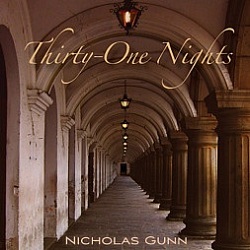 John: Classical music influences are apparent in your compositions, including your new album Thirty-One Nights. What classical music elements, for example structure, rhythm or metrics, do you find most appealing?
John: Classical music influences are apparent in your compositions, including your new album Thirty-One Nights. What classical music elements, for example structure, rhythm or metrics, do you find most appealing?
Nicholas Gunn: I have to say it’s the interplay between rhythm and melody. Being a flautist, I studied mostly counterpoint theory at the academy. We poured over the great composers in detail and I absorbed the constant interplay you find in lead lines, counter melody lines, and the foundation it all sits upon; rhythm. I believe that one essential element of music is structure. Meaning; memorable, reoccurring, lasting melody will always make an impression on the listener over a long extended period of time.
As an instrumentalist I find it even more important to remember this. Strong verse, chorus, turnaround and bridge are vital to great compositions. If the music lacks a lyric and a vocal, I believe it’s even more important to impress structure and melody on the listener. Think about it, music in the moment can be inspirational, but if one can reflect upon a composition because of its melody and literally be transported to that moment in time again, that is the true essence of the music experience on the human experience.
John: What was the turning point when you decided to pursue a challenging career as an artist?
Nicholas Gunn: When I was around 16-17 years old I side stepped flute for a few years and took up drums, playing in both marching band and several rock bands. I literally played the kit in every bar on the Sunset Strip over a three year period including The Whiskey, The Roxy, Madam Wong’s, The Troubadour, etc. It was a great experience at a very young age and it gave me the douse of confidence I needed. I had a brief stint doing some commercials and modeling as well and actually made a few bucks but that’s a whole different story! I came out of this phase “knowing” I guess you could say, that there was only one direction for me, and that was to fully immerse myself into creating my own instrumental music.
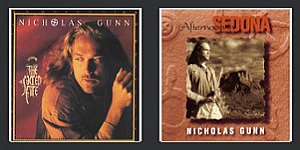 I was a huge fan of Vangelis, Jean Michael Jarre, Pink Floyd etc., and saw that instrumental music had its place in the market and was growing at that time. I bought some recording gear and schooled myself in engineering and production, learning how to get recordings to sound great! I went down to Westlake Studios and other studios in West Hollywood and just hung out asking awesome stupid questions and rubbing shoulders with the best engineers. There was no question afterward that I was fiercely dedicated to making my own music.
I was a huge fan of Vangelis, Jean Michael Jarre, Pink Floyd etc., and saw that instrumental music had its place in the market and was growing at that time. I bought some recording gear and schooled myself in engineering and production, learning how to get recordings to sound great! I went down to Westlake Studios and other studios in West Hollywood and just hung out asking awesome stupid questions and rubbing shoulders with the best engineers. There was no question afterward that I was fiercely dedicated to making my own music.
John: You released your first album Afternoon In Sedona in 1992, and a year later re-released Afternoon In Sedona thru the Real Music record label, which directly influenced sales, and changed the course of your career, isn’t that right?
Nicholas Gunn: That’s pretty accurate I would say. Before being signed to Real Music I had worked pretty hard to get popular retail chains such as Natural Wonders and Nature Company to recognize myself release of Afternoon in Sedona. Those were great retail chains and they focused on a select amount of instrumental titles in their thousands of high end stores. It was easy math really; mass retail exposure, select titles, genre specific, those were great days for sales! I had sent Real Music several submissions of Afternoon in Sedona but it was only until Natural Wonders showed interest they offered me a deal. It made sense for everyone and we re-worked the album a little and re-released in 1993 to moderate success, not big success mind you! There was a heightened awareness of the product but it was not until my second album The Sacred Fire that things changed drastically.
John: That’s right your 1994 release The Sacred Fire, was the first album to make the Top 10 Billboard Charts in the new age category. Were you surprised by making the Billboard Top 10 New Age chart verses another category since your albums can be placed in a broader, instrumental or world music category?
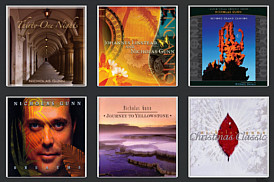 Nicholas Gunn: No, I was not surprised actually. Real Music had made it clear we were binning the album New Age at retail. Back in those days, binning was integral to sales and exposure and once you chose your category, well you’re pretty much stuck, especially if you sell.
Nicholas Gunn: No, I was not surprised actually. Real Music had made it clear we were binning the album New Age at retail. Back in those days, binning was integral to sales and exposure and once you chose your category, well you’re pretty much stuck, especially if you sell.
The New Age chart was an accessible chart as well, meaning it was an emerging genre and not so saturated with other artists. The Sacred Fire actually did not receive its initial success at conventional retail but started selling big at both Natural Wonders and at Nature Company.
The album was literally blowing out the doors holding a #1 chart position in the chains for a year or so. Around this time conventional retail chains such as Borders and Barnes were watching this emerging genre closely and started to expand their New Age Music selections and positioning.
The Sacred Fire album, along with my third album, The Music of the Grand Canyon, which closely followed, was embraced and we finally received chart position through sales at these and similar retail chains.
John: I must say your newest release Thirty-One Nights, which debuted on the Billboard Top Ten New Age Chart, is a beautifully designed album Nicholas. Your albums have consistently made the Top 10 Billboard Charts over the years, so I wondered is making the Billboard Chart is an accurate litmus test for an album’s success over the long haul?
Nicholas Gunn: Thank you John, I am happy to hear Thirty-One Nights resonates with you. This is a great question, but I think it’s important to clarify what Billboard chart position actually means as it seems there is a general misunderstanding of how the system really works. Billboard is an independent trade magazine that reports industry sales via chart position. Billboard receives its sales data from another company called Soundscan.
Soundscan retrieve its sales data from Soundscan retail members. For example, Wal-Mart pays an annual fee to be a member of Soundscan, required by the RIAA (Recording Industry Association of America) that they participate as a major and recognized record retailer. Barcodes at the register are scanned upon sale and sent to Soundscan acknowledging each sale. At major online retailers such as iTunes it is via the embedded ISRC code on the MP3 data through digital download.
 Depending on the zip code of sale, one sale can actually represent two or more sales due to the remote location of the sale and person per capita of the zip code. If you are a small retailer, mom or pop store, or even a significant type of other retailer, then most often, these retailers are not participating members of Soundscan. Sales in turn are not being reported, at all! At the height of my sales through alternative retailers such as Nature Company, Natural Wonders, National Park stores, hundreds of thousands of sales went unrecognized as they were not members of Soundscan. There are no gold or platinum records on my walls despite my significant overall sales within the industry.
Depending on the zip code of sale, one sale can actually represent two or more sales due to the remote location of the sale and person per capita of the zip code. If you are a small retailer, mom or pop store, or even a significant type of other retailer, then most often, these retailers are not participating members of Soundscan. Sales in turn are not being reported, at all! At the height of my sales through alternative retailers such as Nature Company, Natural Wonders, National Park stores, hundreds of thousands of sales went unrecognized as they were not members of Soundscan. There are no gold or platinum records on my walls despite my significant overall sales within the industry.
The Billboard chart positions I actually received over the years were from a fraction of these sales through member participating retailers such as Borders, Barnes, Sam Goody, etc. With that said, while Billboard is indeed an actual litmus test of the success of a title, it does not represent the overall sales performance of a title accurately. My mentor, Harvey Cooper, always said; “Comments and opinions of music are only perceptions but real sales are a true indicator of commercial success.”
John: On your fourteenth album Thirty-One Nights, I must say you have a great team with vocalist Dana Kemmerle and guitarist Chris Fossek. How did you meet Dana and Chris, and could you tell us about the project you created together?
Nicholas Gunn: I met both Chris Fossek and Dana Kemmerle in Santa Barbara, CA. Chris was a local accomplished musician, who has been playing the Santa Barbara circuit for some time. I heard him at a local wine bar and quickly realized this guy had great technique and style. At that time I was starting to formulate what I wanted to do for a new album and listening to him play was really inspiring! I got to know Chris over a period of months before we started tracking together and we became tight friends.
We are the same kind of people, infusing our music with our life experiences! Chris wrote several pieces on the album which allows it to transition beautifully at two main points; Candle Dance & From Water to Wind. Chris also wrote the title track Thirty-One Nights which sets the tone of the album so well. Dana is an absolute breathe of fresh air. After deciding to finish her graduate degree at UCSB in global studies our paths crossed at the very same wine bar I first met Chris in.
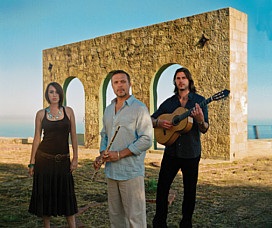 Dana has been the core inspiration behind the experience and story that became Thirty-One Nights. I was going through a very difficult time with many changes in my life and she was continuing on with her studies in Spain and in Mexico. We became romantically involved and the next thing I know I asked her to record some spoken word vocals on a track that became track 13 Recuerdame, on the album.
Dana has been the core inspiration behind the experience and story that became Thirty-One Nights. I was going through a very difficult time with many changes in my life and she was continuing on with her studies in Spain and in Mexico. We became romantically involved and the next thing I know I asked her to record some spoken word vocals on a track that became track 13 Recuerdame, on the album.
She has a gorgeous balanced tone in her speaking voice and it was an instant match and hit for me in the studio and many more tracks followed! It’s difficult to make spoken word work within music; it has to be just right! Dana and I now work passionately together in many aspects of our lives. We spent thirty one nights together in Mexico recording flutes on top of Mayan pyramids and writing poetry deep in the jungle. She’s one smart cookie, has a healthy and balanced perspective on life, and someone I want to associate and grow with for a very long time.
John: What are the vital key elements Dana and Chris convey to your instrumental with vocals composition Thirty-One Nights?
Nicholas Gunn: Well, Chris comes from an extremely studied background in music with a master’s degree from Cal Arts in Flamenco guitar. It was important to me that I had an authentic approach and sound for Thirty-One Nights. Authentic Flamenco playing includes so many different aspects, such as the knocking on the guitar body, types of open strumming and closed strumming and where picking occurs over the sound hole. Even finer details, such as which part of the finger nail is used to create different sounds against the string, are all important factors!
The guitar itself is vital to the sound. Chris plays on a handcrafted Manuel Bellido guitar which includes design features such as a wider neck and intricate body/sound hole design. Nylon strings are always used, of a certain type, and after a certain amount of wear. There are no pickups used in recording and a single microphone placement to capture a clean natural sound. These are all important factors that create a certain resonance consistent with Flamenco guitar. His writing style is also different than mine which lends to a well-balanced album that transitions at all the right spots. It’s a good partnership in that we are different in all the right ways! With Dana it is about a personal and emotional connection that is intimate.
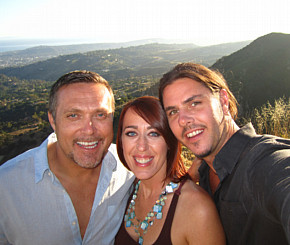 We experienced Thirty-One Nights together in real time and she has watched, supported, and participated in the unfolding of the album over a year and a half. She has a beautiful speaking voice and her bilingual abilities were a perfect and authentic evocative addition to the album. I have used spoken word sparingly before, and I am telling you, it’s a hard thing to pull off! Dana just had this tone and approach that was, well otherworldly, very seductive such as on The Swallows of Na’ Lu’um. We walked together through jungles, remote Mayan pyramids, went cave diving in Senotes, and used this experience to fuel creativity. Dana wrote about her experiences and created poetry centric to the experience. Dana and I are continuing to work on other exciting projects and in business together. We are partners in many ways.
We experienced Thirty-One Nights together in real time and she has watched, supported, and participated in the unfolding of the album over a year and a half. She has a beautiful speaking voice and her bilingual abilities were a perfect and authentic evocative addition to the album. I have used spoken word sparingly before, and I am telling you, it’s a hard thing to pull off! Dana just had this tone and approach that was, well otherworldly, very seductive such as on The Swallows of Na’ Lu’um. We walked together through jungles, remote Mayan pyramids, went cave diving in Senotes, and used this experience to fuel creativity. Dana wrote about her experiences and created poetry centric to the experience. Dana and I are continuing to work on other exciting projects and in business together. We are partners in many ways.
John: Would you like to tell us more of the story for Thirty-One Nights, and inspiration behind the songs?
Nicholas Gunn: There is a special Thirty-One Nights storybook PDF, with personal photos, that is embedded on the CD and is also available with a full album download. It would be my pleasure to share this with your readers and is the best way to answer this question. Enjoy!
John: I read Thirty-One Nights had a release date of September 11, 2012. Was there any significance of releasing Thirty-One Nights on 9/11, a date now recognized as the American Federal Holiday – Patriot Day?
Nicholas Gunn: No, not at all. Here is the thing; September 11th is a recognized national street date with most major music distributors. This street date has long been in place before the unfortunate events of 9/11. I decided to sign with label Spring Hill Media, distributed by Allegro Media and their system adheres to these dates. I try not to make any political or religious references in my music and this date did not influence me in any way. A broad stroke approach to creating provocative, moving, and inspirational music is my only goal.
John: You have a great number of National Park records, which began under Real Music Record Label. The Music of the Grand Canyon, Beyond Grand Canyon, Through the Great Smoky Mountains, Journey to Yellowstone, plus there are others. How and why did you become involved with the production of National Parks releases?
Nicholas Gunn: Shortly after The Sacred Fire was released (1994) Real Music approached me about a series of recordings they were developing called The National Park Series. I believe they already had one in the bag and it had sold well in its early stages focusing on park stores and alternative retail such Natural Wonders and Nature Company. The idea fit perfectly into the current trend and retail base. My albums initially were inspired by natural surroundings so it was a perfect fit. It was a huge success and continues to be a great catalog album. Naturally, I continued to release additional National Park albums based on request as well as desire to sustain sales and awareness for our National Parks.
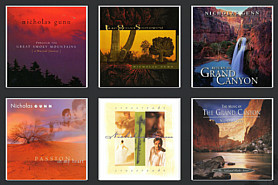 John: Every one of your National Park albums is like a colorful canvas. Each has their own merits, but how would you best describe the sound qualities of your National Park releases?
John: Every one of your National Park albums is like a colorful canvas. Each has their own merits, but how would you best describe the sound qualities of your National Park releases?
Nicholas Gunn: Cinematic is the word that always comes to mind for me. Cinematic music to me is like a soundtrack to be played against experiencing these natural wonders. Over and over again, I have received letters and emails from folks saying “we drove to the South Rim listening to The Music of the Grand Canyon” or “hiked the Appalachian Trail listening to Through the Great Smoky Mountains.”
Like Thirty-One Nights these albums were inspired, in essence, by travel and geographic location. The only difference being that my artist persona somewhat hid behind the National Park theme.
John: In the late 1990’s you founded the Anagram Records Label, and earlier you founded Gemini Sun Records, a label with numerous award-winning artist, many of whom were artists like yourself who made the Top Ten Billboard Charts. Who are some of the artists on the Gemini Sun Record Label under your direction?
Nicholas Gunn: Anagram existed for only around a year or so when I was previously married and it had two other license deals, one with Mars Lasar and one with Loren Gold as well as Cheryl Gunn’s titles and a few of mine as well. When I was divorced, Anagram dissolved and I started Gemini Sun Records. Gemini Sun Records also closed for business in 2009. Both were started as a way to represent artists in the genre of New Age/World Music that was steadily shrinking.
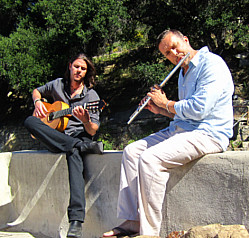 Labels such as Higher Octave, Windham Hill, and Narada were closing or being sold off to the majors as their assets in masters and publishing were the only thing left, sales were dwindling fast! The days of supporting retail such as Natural Wonders and Nature Company were now gone and artists coming off of these closing labels needed a home. Gemini Sun became that home for a select few; David Arkenstone, 2002, Mars Lasar, Medwyn Goodall, through MG Music, Loren Gold, and myself were just a few of the artists it represented!
Labels such as Higher Octave, Windham Hill, and Narada were closing or being sold off to the majors as their assets in masters and publishing were the only thing left, sales were dwindling fast! The days of supporting retail such as Natural Wonders and Nature Company were now gone and artists coming off of these closing labels needed a home. Gemini Sun became that home for a select few; David Arkenstone, 2002, Mars Lasar, Medwyn Goodall, through MG Music, Loren Gold, and myself were just a few of the artists it represented!
John: Would you like to tell us some of the highlights and other aspects, including the drawbacks of owning your own record label?
Nicholas Gunn: In my opinion, it’s a trap in many ways and little positive to talk about. It’s a thankless job that few take on to the degree I did as an artist owned label. I took it on to increase my profitability per sale, to make a difference in a market segment, and to represent great music and artists allowing them to own their own property (masters and publishing). Most artists block the desire to want to know or deal with national distribution, marketing, and promotion – and for good reason! It’s as stressful as hell!
The intricacies of managing the small margins associated with indie national distribution, marketing, and promotion of a niche label within a declining industry, within a declining economy is nothing short of a nightmare! Distributors are set up to protect their bottom line, at all costs! By cross collateralizing all returns, marketing, and promotion against all sales, the music business on this level is nothing more than a consignment business at massive risk to the label. If you couple that with major retailers who fail to comply with retail campaigns but then charge for the advertising they failed to comply with, it’s a fundamentally flawed system that produced the music industry we see and experience today.
John: The entire music industry as a whole has greatly changed over the years since you began producing music. What are some observations you have made over the years, and in what way has the music industry changed, for better or worse?
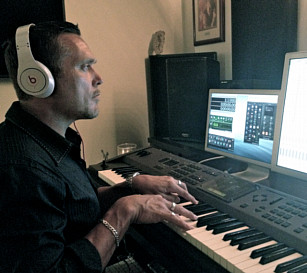 Nicholas Gunn: It’s still finding its way, but for the better! Like any business, it’s all about supply and demand and there is little demand for music sales as it used to exist. Music sales are not the future that I am relatively sure of! The use of music continues to be high, but through streaming, illegal downloading and sharing, and second hand online sales from the massive returns and recycling of the music industry as a whole. It’s all spread very thin at little profit to anyone, including the labels. I think there are a few models to watch, one of which would be the Electronic Dance Music market (EDM).
Nicholas Gunn: It’s still finding its way, but for the better! Like any business, it’s all about supply and demand and there is little demand for music sales as it used to exist. Music sales are not the future that I am relatively sure of! The use of music continues to be high, but through streaming, illegal downloading and sharing, and second hand online sales from the massive returns and recycling of the music industry as a whole. It’s all spread very thin at little profit to anyone, including the labels. I think there are a few models to watch, one of which would be the Electronic Dance Music market (EDM).
This is a model that has been born in the new distribution and profiteering age of music. Here is a platform with which DJ’s are now producing their own content in the studio and performing through the DJ method at low cost and extremely high output. The concept of sales has never been a priority and sharing/remixing within the community is embraced as a way to popularize the genre and its originating artist. The revenues are in packing 100,000 fans into a venue with the requirement the DJ/Producer simply show up with their gear over their shoulder! It’s brilliant!
The top ten DJ/Producers last year collectively made 127 million dollars and stand atop the industry money making leaders. Now, I am not talking about wedding DJ’s, I am talking about talented DJ/Producers – there’s a big difference! Secondly, and this is important I believe, we need to realize that music, especially in recorded form, is now highly dispensable and transferable. A great song, performance, and recording is still just that, great! It will always be consumed, but the real question becomes what will be the support mechanism that will allow for the creation and performance of this content?
Successful artists have a somewhat self-sustaining system, however how does a new unsigned artist become self-sustaining? I believe we are reverting back to the times when art was supported by benefactors and leaders within both business and government. Companies need art to further define and align their products within the marketplace, and leaders of countries will continue to require education and culture in arts to further the human race. It’s now about selling your talent to a group that needs your involvement to further its own cause, that’s how I see it.
 John: Can you foresee any trends developing that may influence your work and perhaps the work of other artists as a whole?
John: Can you foresee any trends developing that may influence your work and perhaps the work of other artists as a whole?
Nicholas Gunn: Quite frankly, this is my last album in the genre for the foreseeable future. I have a great passion for all music and the music business itself and I find the trend of developing more instrumental music within the current instrumental market place quite frustrating and stifling. There really are no venues that support the live performance of this genre and sales are at an all-time low. It’s a testament to my love of the genre that has produced Thirty-One Nights. I wanted to have an album I personally could be really proud of as my departure album.
On the side over the years I have produced my fair share of EDM as it does tend to border on instrumental at times. I have partnered with artist/vocalist Carmen Rainier and we have a project in the works titled (We Are) Nexus. It’s refreshing and invigorating to be a part of a larger and emerging music community that fully embraces the future of the music business. I am a musician and producer first and foremost and I got into this business for my work to be heard. This is the next chapter of my musical career.
John: I heard Thirty-One Nights is on the upcoming nomination ballot for Best New Age Album in the 55th GRAMMY® Awards on Feb. 10, 2013.You will know if nominated on December 5, 2012 isn’t that right, and is there any manner in which Nicholas Gunn fans can support your nomination for a possible music award?
Nicholas Gunn: Actually, it is on the ballot for Best World Music Album which I believe is more appropriate for the album itself. Yes, December 5th is when I will know if Thirty-One Nights receives a nomination. The award is really a peer recognition process of which fans have little part in unless they are a voting member of the academy. All I can say is that after 14 albums, two million sales, and 55 consecutive weeks on the Billboard chart it would be nice to be recognized by my peers; however it will not change the way I go about developing the next chapter of my musical career.
John: Naturally a GRAMMY® Award would put you in the spotlight as an artist, but aside from your own talents as a musician, what external factors have been the greatest influences to your success?
 Nicholas Gunn: I would say it’s in taking the risk of wearing all these hats over the years as an artist, writer, producer, engineer, label owner. They all make up for my experience in the business and how I now see the business. Granted, closing my label was an awful experience but liberating and defining all at the same moment. Every passionate path is littered with debris of some sorts and it’s having those experiences that have given me a greater understanding of what I want and what I don’t want. I believe my most successful days lie ahead of me because of this.
Nicholas Gunn: I would say it’s in taking the risk of wearing all these hats over the years as an artist, writer, producer, engineer, label owner. They all make up for my experience in the business and how I now see the business. Granted, closing my label was an awful experience but liberating and defining all at the same moment. Every passionate path is littered with debris of some sorts and it’s having those experiences that have given me a greater understanding of what I want and what I don’t want. I believe my most successful days lie ahead of me because of this.
John: During your career you have contributed money to the National Park organization, American Lung Association, plus you are on the board of directors for the Children’s Creative Project (CCP), in Santa Barbara, California. Clearly the arts and music education for children and other charitable organizations are important to you. Would you like to tell us about your Philanthropy work, and why it is important to you on a personal level?
Nicholas Gunn: Arts and education for children is paramount. I am a result of parents and a system that exposed me to a finer education in art and music. As a society, we tend to embrace mediocrity as a way to shy away from having to learn more about something, it’s an innate human trait. I sit on the board for the Children’s Creative Project because it grants much needed funding for events that expose children to fine art. It’s simply a matter of proper exposure. We become mediocre when we get older, but we are not that way as children. We learn what we are taught and we soak it all up, no matter which way it comes at us early in life. Real Music initiated the donation to The Grand Canyon Association from sales of The Music of the Grand Canyon.
 It was and still is a wonderful cause as the money promotes education and awareness of preservation to both children and adults. This trend carried forth for me through realizing it’s important to give back in this manner. Money is cyclical. You have to give as much as you receive.
It was and still is a wonderful cause as the money promotes education and awareness of preservation to both children and adults. This trend carried forth for me through realizing it’s important to give back in this manner. Money is cyclical. You have to give as much as you receive.
John: I would love to release some Nicholas Gunn news about a new project or a concert tour in the planning stages. Is there any additional news you would like to officially announce today?
Nicholas Gunn: I am sorry to say I think the biggest news might be found in my departure from the genre for the foreseeable future. But on a positive note, I have much to give and much to share, only within a different genre. I recently launched a new current events news page at NicholasGunn.com/News. I recommend everyone visit to see what’s new there!
John: Nicholas you are a legendary instrumental artist, regardless of genre or classification, and that my friend will never change! Needless to say I trust we will have a chance to interview again in the future. In closing for now, I want to thank you again for giving everyone this opportunity to find out the latest news about you, and your newest project with Dana Kemmerle and Chris Fossek. Is there anything you would like to say before we close, or express to the fans that have supported you over the course of your career?
Nicholas Gunn: I do want to thank, from the bottom of my heart, the valued fans that have supported me over the years. For passionate people such as you John that still see the value and potential in this beautiful genre of music. There are so many people really, over the years, that have helped me realize my goals, and of course I thank them all. I am eternally grateful.
For more information visit NicholasGunn.com. Sample or purchase albums and songs at the Nicholas Gunn music shop. Find details like the making of Thirty-One Nights, info about Dana and Chris, and visit Nicholas at social sites like Facebook. You can also find albums at major online music stores, including the artist page for Nicholas Gunn at Amazon.com. Interview photos are courtesy nicholasgunn.com & Big Stock Photo – Ardith.
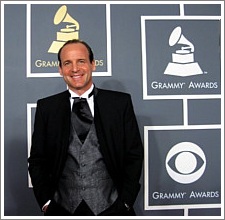 Pre-release Album Review: The Maiden of Stonehenge by three times GRAMMY® Nominee Dr. Michael Brant DeMaria.
Pre-release Album Review: The Maiden of Stonehenge by three times GRAMMY® Nominee Dr. Michael Brant DeMaria.
Award-winning Michael Brant DeMaria is a three times GRAMMY® Nominated recording artist, psychologist, author and speaker with a dramatic new soundtrack album for 2012. Four years in the making, The Maiden of Stonehenge is a musical soundtrack to an original theatrical play of the same title co-written by Michael DeMaria and Stephen C. Lott.
Michael DeMaria is an esteemed artist in the new age music community, and like all of his arrangements, The Maiden of Stonehenge is both a significant release and highly anticipated new album in 2012.
Michael DeMaria’s three GRAMMY® Nominations for Best New Age Album of the Year, Bindu, Gaia, Ocean & Siyotanka each have risen to the top #1 position on Zone Music Reporter’s Radio Charts in the New Age Albums category.
Extensive worldwide radio coverage of his four releases in the Ontos Healing Sound Project at XM/Sirius Radio, Soundscape Cable, Satellite and internet radio stations has led to numerous Zone Music Reporter’s Best Album Awards.
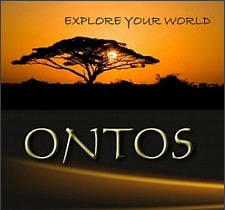 First in the Ontos Healing Sound Project Siyotanka won a Native American Music Award and earned a GRAMMY® Nomination in the Best Native American Music Album category, and won ZMR’s Best Native American Album in 2009.
First in the Ontos Healing Sound Project Siyotanka won a Native American Music Award and earned a GRAMMY® Nomination in the Best Native American Music Album category, and won ZMR’s Best Native American Album in 2009.
Second in series Ocean won Zone Music Reporter awards in two categories of Best Ambient Album of 2009 and Best Relaxation/Meditation Album of 2009. Gaia likewise was awarded in the two categories of Zone Music Reporter’s Album of the Year and Best World Album. Earlier in 2012, Michael Brant DeMaria’s fourth in the Ontos Healing Sound Project series Bindu debuted at #1 and remained on ZMR’s New Age Radio Chart for two months in a row.
The Maiden of Stonehenge is the most elaborate musical odyssey Michael Brant DeMaria has brought to life yet. Familiar with every one of his releases, Michael’s new album for 2012 will surprise anyone acquainted with his earlier arrangements. The soundtrack recording wonderfully illustrates the story based theme for a musical journey centered on the life and adventures of an young orphan girl in ancient Britain as she finds her way to the ancient Circle of Stones.
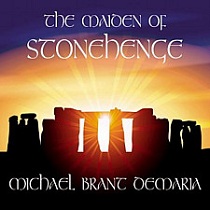 Although Michael performs on a number of ethnic flutes, keyboards, and synthesizers like earlier releases, listening to his newest album was truly a revelation since each song is conveyed in unique fashion to all other songs from previous albums. For the first time vocals are uniquely integrated into a number of songs by Michael, and of lead vocalist Maggie Crain on the songs Chantress & Stonehenge.
Although Michael performs on a number of ethnic flutes, keyboards, and synthesizers like earlier releases, listening to his newest album was truly a revelation since each song is conveyed in unique fashion to all other songs from previous albums. For the first time vocals are uniquely integrated into a number of songs by Michael, and of lead vocalist Maggie Crain on the songs Chantress & Stonehenge.
Beginning with the deeply mysterious first overture Lost Village to the harmonious conclusion in the final song Stonehenge, each scene is crafted to reveal a vivid musical adventure. Inside the audio CD album, cover notes give the setting to each of the 13 songs that enable the listener to follow the storyline.
The Sounds True record label is another store where you can find the two albums In The Flow & Solace. Both albums are designed for patient therapy and emotional well-being in his professional role as a Music Therapist. The Maiden of Stonehenge is the most impressive album to compliment the long linage of award-winning albums by new age, instrumental and world music recording artist Michael Brant DeMaria.
Visit Michael Brant DeMaria’s Ontos.org music section to sample and purchase his albums, or visit the store page for Michael DeMaria at Amazon.com, CDBaby and iTunes. The Maiden of Stonehenge is a pre-release currently available at major online stores prior to the official release date of winter 2012-2013. Photos and cover artwork are courtesy ontos.org.
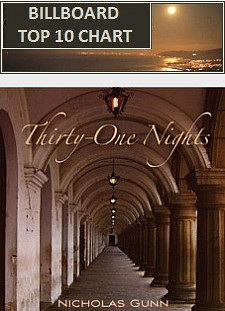 Thirty-One Nights by Nicholas Gunn in Billboard’s Top 10 Chart.
Thirty-One Nights by Nicholas Gunn in Billboard’s Top 10 Chart.
The newest album by Nicholas Gunn has apparently been a popular new hit album at Billboard for the week of September 29, 2012.This week Nicholas Gunn’s new instrumental album titled Thirty-One Nights, made its debut at #8 in the Top 10 New Age Charts at Billboard.
Thirty-One Nights is the 14th album by Nicholas Gunn after an interval of 5 years. On this newest release he, Dana Kemmerle and Chris Fossek communicate the splendor of the natural world and beauty of its environment. Earlier this week in my album review, I spoke of the uncompromising instrumental qualities, intensity and passion in which flutist Nicholas Gunn and team dedicated to this release.
For the acclaimed flutist Nicholas Gunn, making the Billboard Top 10 Charts is more the rule and not the exception, having spent a total of 55 consecutive weeks overall on the Billboard New Age Charts.
With over two million in album sales, Nicholas Gunn has consistently shown he is a dominate force at producing beautiful instrumental music. Congratulations go to flutist Nicholas Gunn, vocalist Dana Kemmerle and guitarist Chris Fossek.
Sample and purchase Thirty-One Nights at NicholasGunn.com.
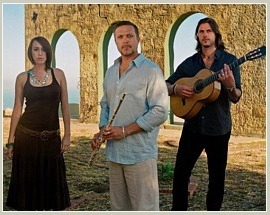 New Instrumental Music Review: Thirty-One Nights by Nicholas Gunn, with vocalist Dana Kemmerle and guitarist Chris Fossek.
New Instrumental Music Review: Thirty-One Nights by Nicholas Gunn, with vocalist Dana Kemmerle and guitarist Chris Fossek.
Instrumental new age recording artist Nicholas Gunn has always been intensely passionate about his flute music, and his new instrumental album, Thirty-One Nights is no exception to the rule.
For the acclaimed flutist Nicholas Gunn, who made Billboard’s Top 10 Charts, with 55 consecutive weeks overall on Billboard’s New Age Charts, and over two million in album sales, Nicholas Gunn is clearly a master at producing instrumental music that touches one in a profound way.
Thirty-One Nights, which is his 14th album after an interval of 5 years, is a significant new release by its uncompromising instrumental qualities.
Thirty-One Nights is like a case study of the depth and beauty in which he, Dana Kemmerle and Chris Fossek communicate the splendor of the natural world and beauty of its environment. Nicholas Gunn traveled to the Yucatan Peninsula in Mexico and spent 31 days in the Caribbean shoreline to find inspiration for this project. As if researching a part for a movie role, his true life experience of one month devoted to nature in its purist form is recreated and brought to life on Thirty-One Nights.
 The real time connection of a scenic, tropical atmosphere gives reflective depth and balance to the 13 songs of serenity that waltz hand in hand with songs rich in auditory intensity. Beautiful acoustic instrumentals and vocals paired with flute are key elements that have made this recollection one of true excitement.
The real time connection of a scenic, tropical atmosphere gives reflective depth and balance to the 13 songs of serenity that waltz hand in hand with songs rich in auditory intensity. Beautiful acoustic instrumentals and vocals paired with flute are key elements that have made this recollection one of true excitement.
Two professional artists in accompaniment are vocalist Dana Kemmerle singing soft poetic verses on a number of songs and Chris Fossek, himself a wonderful guitarist well versed in Flamenco guitar tradition.
For the classically trained flutist Nicholas Gunn, re-living the sight and sound experience has without exception, proven to be a wonderful true life excursion worth sharing. Included in the audio CD is an embedded journal about the creation of the album, and a 10 page cover booklet with bi-lingual lyrics.
The 13 songs on Thirty-One Nights are titled: Remember Me Prelude, Fiesta Patria, Thirty-One Nights, The Swallows of Na’ Lu’um, Veracruz, Condesa, Candle Dance, Someday, Full Moon Over Calle 12, Road to Merida, On the Shores of Tulum, From Water to Wind, & Recuerdame.
Visit NicholasGunn.com and sample or purchase Thirty-One Nights at his store. Photo is courtesy nicholasgunn.com.
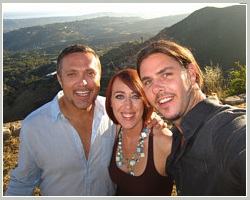 Song Sample: Thirty-One Nights by Nicholas Gunn.
Song Sample: Thirty-One Nights by Nicholas Gunn.
Thirty-One Nights is a new album by the platinum selling recording artist and instrumentalist Nicholas Gunn. The acclaimed flutist Nicholas Gunn’s newest release is anticipated by many persons having been 5 years after the earlier release of another fine album titled Encanto from 2007.
Thirty-One Nights is a vibrant new release with 13 instrumental songs of original music performed by an ensemble of flute and guitar, with vocals on a number of songs. Full Moon over Calle is the song sample video shown below.
The two music professionals joining Nicholas Gunn on Thirty-one Nights is vocalist Dana Kemmerle and guitarist Chris Fossek. Coming next is an album review for Thirty-one nights at New Age Music World. You may sample songs and purchase at NicholasGunn.com. Photo is courtesy nicholasgunn.com.

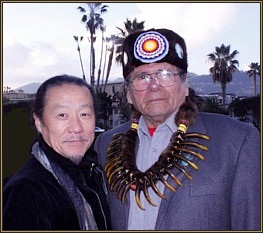 Pre-release Review: Let Mother Earth Speak by Dennis Banks & Kitaro. New spoken word album with song single included entitled Peace, available in audio CD and digital downloads.
Pre-release Review: Let Mother Earth Speak by Dennis Banks & Kitaro. New spoken word album with song single included entitled Peace, available in audio CD and digital downloads.
Distinguished Native American activist Dennis Banks has teamed up with international new age superstar and GRAMMY® Award-winning Kitaro for his new album titled Let Mother Earth Speak.
This unity of Dennis Banks, who provides spoken word narrative, and Kitaro who accompanies Dennis with world-class instrumentals, is a world apart culturally speaking from the music customarily heard in modern day society.
Let Mother Earth Speak is an exclusive new release like no other in the genres of spoken word, along with traditional Native American music. Introducing 9 songs total on the album and the life history of Dennis Banks, an Anishinabe from the land of the Ojibwa people, is delivered by spoken word and traditional Native American Indian songs.
Kitaro’s instrumentals of keyboards, Native Indian Flute, percussion, and ethnic woodwinds transcend the message of peace and real life stories with a sense of inspiring realism. Artists Tomoko Koshikawa and Kirilola sing background vocals.
There is a sense of authenticity in the voice of Dennis Banks given the down to earth clarity in which he uses spoken word to encourage a more peaceful existence, while recalling past memories and wisdom learned from the experience.
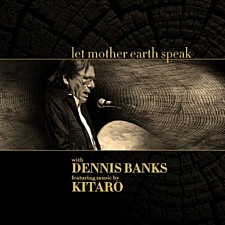 Sharing oneness with the earth in which they live day to day, Dennis Banks and Kitaro each embolden the message of international peace in their own lives as individuals. Together as a team, their encouraging message speaks of peace and harmony with new-found optimism, making the elusive goal of world peace seem less abstract and more like a compellingly real concept within arm’s reach.
Sharing oneness with the earth in which they live day to day, Dennis Banks and Kitaro each embolden the message of international peace in their own lives as individuals. Together as a team, their encouraging message speaks of peace and harmony with new-found optimism, making the elusive goal of world peace seem less abstract and more like a compellingly real concept within arm’s reach.
Domo Music Group is presenting this arrangement by Dennis Banks and Kitaro. This album will be interesting to watch since this project will be submitted for GRAMMY® consideration in the Spoken Word category in 2012 – 2013.
Receiving nomination or a GRAMMY® Award for Best Spoken Word Album will be a challenge however since past winners include 2012 Winner Betty White, plus former and current U.S. Presidents Jimmy Carter, Bill Clinton and Barack Obama.
This new album composed and arranged by Dennis Banks and Kitaro, is timed to be officially released on September 11, 2012. You may sample or purchase this album right now with 18 page cover booklet containing photos and song lyrics at Domo Music Group and iTunes.
Let Mother Earth Speak has 9 songs titled as follows: Thank You Great Spirit, Song Of Responsibilities, The Missionary Song, A Good Day To Die, Don’t Cry, End Of The Day, She Don’t Love Me Anymore, Longest Walk 2 and Peace.
Visit DennisBanks.org to learn more, and to sample or purchase visit the Domo Music Group pages for Dennis Banks and the Domo Music Group pages for Kitaro. Cover artwork courtesy dennisbanks.com & kitaromusic.com.
Planet Earth from the beginning was destined to be one of our greatest mysteries, where every life form and those yet to be discovered remain more dependent on our mysterious world rather than this blue planet would ever depend on us. Simply put, we know Earth can survive without us, and in fact our present day endeavors to save the world is a statement equivalent to saying hey everyone, let’s save ourselves!
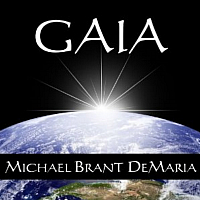 Michael Brant DeMaria, PH.D, is a clinical psychologist, lecturer, and award winning musician from Florida with a revitalizing new concept album honoring our shared heritage with the Earth by the World influences in Gaia, an innovative and exceptional brand new release in his widely acclaimed Ontos Healing Sound Project.
Michael Brant DeMaria, PH.D, is a clinical psychologist, lecturer, and award winning musician from Florida with a revitalizing new concept album honoring our shared heritage with the Earth by the World influences in Gaia, an innovative and exceptional brand new release in his widely acclaimed Ontos Healing Sound Project.
Gaia is essentially the achievement of over 25 years in personal and professional research by Michael into the fundamental principles of auditory healing techniques. His New Age Ambient release The River began the first origins of the Ontos Healing Sound Project while leading to the Healing & Meditation release Ocean, which remained at number 1 for 3 months on the monthly charts then having ended the year 2009 with ZMR’s Best Ambient & Best Relaxation Album Awards.
Ocean and was first conceived to help hurricane survivors begin anew and return to a more peaceful existence, but then after the 2010 Gulf Oil Disaster, Ocean became a second symbol of recovery since Michael donated his time performing concerts around the Gulf Coast Region, along with donating a portion of sales proceeds for the still ongoing wildlife recovery. I was pleased to learn Ocean is under consideration for a 2010 New Age Grammy Nomination.
Gaia is a serene excursion into the Ontos Healing Sound Project by directive of Michael Brant DeMaria. Therapeutic by a graceful vibrancy that effectively renews the inner spirit akin to The River & Ocean; the innovative world music inspirations found in Gaia heighten these emotive sensations of calm and well-being while ascertaining our undeniable relationship with planet earth.
Siyotanka is the story based narrative and soundtrack score that secured a Native American Music Award ( NAMA ) in the Native Heart category, and then lead to his Grammy Nomination for Best Native American Music Album, along with winning the Best Native American Album at year ending ZMR Music Awards for 2009.
Gaia has every hallmark for success since nearly every album produced by Michael Brant DeMaria has earned awards and respect from those in the music industry, and rightly so. Michael’s music, books, art, and poetry have acquired recognition in the United States along with widespread international acceptance in Australia, Europe, and Russia, having touched many lives with his universal message.
 Third in the Ontos Healing Sound Project Gaia is based in part on the Greek Goddess Gaia, along with esteemed Earth Scientist Dr. James Lovelock’s Gaia Hypothesis, whose research studies involving planetary exploration while at NASA led to his famous Gaia Hypothesis which interprets the Earth we share as one cohesive single living organism.
Third in the Ontos Healing Sound Project Gaia is based in part on the Greek Goddess Gaia, along with esteemed Earth Scientist Dr. James Lovelock’s Gaia Hypothesis, whose research studies involving planetary exploration while at NASA led to his famous Gaia Hypothesis which interprets the Earth we share as one cohesive single living organism.
Gaia ( Title Song ) is the musical genesis of 14 tonal poetries and sound prayers traversing many nations and cultures, opening with a lighter piano melody, where World and Native American wood flutes in amended resonance on every song begin their ethnic exploration and develops into a wonderful first prelude to the ever changing stages in this moving expedition.
Anima Mundi tells of an emergent period and where Michael uses his voice as a human instrument to speak for the ancestors of our past. The surreal Alchera features Australian ( didgeridoo ) ever present wood flute instrumentals and vocal exhalations to denote the Earth as a single living entity of magnificent beauty.
Asase Yaa, with fine qualities of African rhythms and Amazonia, with South America textures are together moderate in rhythm, having unifying world flute instruments and percussions in each melody, even during the deep and mystical atmosphere of Ja’neba. The silk road to China is traversed by highly symbolic gong strikes in Xiaolin, along with Chinese flute ( Xiao ) in akin song Kuan Yin with traditional (Yueqin ) strings instrument dramatizing the orient with vibrancy.
Gentle imprints of Japan are represented by bamboo flute ( Shakuhachi ) and the gentle breeziness of wind chimes leave fine impressions in Zazen & Tarani, likewise revealing Michael’s fine transition in World music personified on Gaia, along with the notion that our enduring heritage of dependency we share with planet Earth will always be just a simple fact of life.
Visit ontos.org to sample / purchase or visit his CDBaby.com page or major music outlets. Visit michaeldemaria.com blog and read a recent in-depth interview with Michael and I, and my album reviews of his award-winning music on my pages dedicated to Michael Brant DeMaria. Picture copyright Big Stock Photo – Shutter.
Ann Licater has just released a brand new follow up to her opening debut Following the Call, a release which received nomination of Best Native American Album and listing in the top 12 Contemporary Albums in 2007.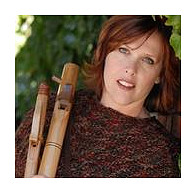
This first effort began her journey of recognition as a top solo flutist performing on Native American, World and silver alto flutes and had begun the chosen pathway towards her next success.
Doorway to a Dream is the 2010 release from Ann Licater that again displays her level of expertise in both traditional and indigenous flutes while accentuating the fine attributes woodwind instruments can produce. The 14 original songs and improvisational compositions this time around however are during collaboration with accompanying musicians and becomes a perfect album discovery for those who appreciate the smooth sounds of tranquil and relaxing music.
Ann Licater is well rehearsed in classical silver flutes having began her own journey into Native American & World flutes years ago after listening to the unique sounds indigenous flutes can produce, having studied with master flutist R.Carlos Nakai at the Renaissance of the Native American Flute which nicely reinforces the comprehensive skill level of her already accomplished classical flute studies.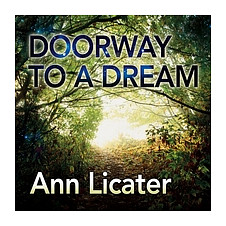
Many of the indigenous instruments Ann plays on this album are selected for their unique tonal qualities and include Native American-style, Chinese Rosewood Xiao, Zapotec Triple Clay, Anasazi and Alto flutes.
In addition to her recordings, Ann Licater teaches in workshops and during concerts, describes to her audiences the origins for each of the clay and wood instruments featured during her appearances.
Doorway to a Dream is a natural contrast to her first solo album by inclusion of recognized artists who incorporate their talents and help expand her original compositions by collaborative instrumentation of Middle Eastern Tar, African udu Coral electric sitar, Edo period Japanese shakuhachi, flugelhorn, acoustic guitar, piano, keyboard and World percussion.
Whether you are searching for music with the unique intonation flutes can produce when placed in the hands of an accomplished musician, or simply enjoy the finer sounds produced by music professionals, Doorway to a Dream is a natural choice.
The world class musicians accompanying Ann Licater on various songs throughout this album and you are sure to recognize are Jose’ Neto, Jeff Oster, Peter Phippen, David DiLullo, Troy Arnett, William Hoshal and Shambhu. This album was mastered by award winning Engineer Stephen Hart.
Visit fluteforthesoul.com to sample / purchase or at her CDBaby.com page.
Photo courtesy of Greg Crowder.
Michael Brant DeMaria, PH.D, is a recent Grammy Nominee making the news lately. Likewise, our recent interview together gave many people an in-depth look into the life of a clinical psychologist, composing musician, poet, author, and dedicator of his Healing Sound Series.
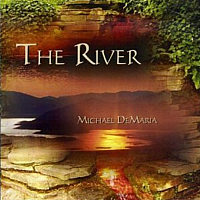 Knowing Michael better now, it’s clear to me his music is an instrumental model in itself, much like his art, books, and poetry, all of which have acquired U.S. recognition, along with international acceptance in Australia, Europe, Russia, and other parts of the world.
Knowing Michael better now, it’s clear to me his music is an instrumental model in itself, much like his art, books, and poetry, all of which have acquired U.S. recognition, along with international acceptance in Australia, Europe, Russia, and other parts of the world.
In his psychotherapy practice, Dr. DeMaria created ONTOS (Greek for Being) to help people live more meaningful and effective lives by ambient music interwoven as relaxation therapy. I feel The Series can be perceived much like a form of cognitive conditioning, becoming an audible portion of his personal inner message by design, helping one acquire a new perspective and begin a refreshing journey on a path to wellness through calming music.
The River first began the Healing Sound Series, with Ocean his second project based on over 25 years of personal and professional research in the fundamental principals of sonic healing techniques. Ocean was conceived to help hurricane survivors much like himself, begin anew and return to a more peaceful existence.
Where our rivers are a beginning source during their natural paths across the landscape, The River by Michael Brant DeMaria is like a template to discover a new direction, if even for a single day. In addition, while help customarily arrives in the form of understanding words from this highly educated man during his medical practice, Michael’s healing music has a similar philosophy. It is where gentle curves in The River now become the stimulus equivalent for discovering a natural direction in which to travel.
Siyotanka is the third story based narrative that won a Native American Music Award in the Native Heart category, and placed him on the Grammy ballot for Best Native American Music Album, also retaining the # 1 position on ZMR Top 100 charts in December 2009. “The River is an album dedicated to all who listen from the heart” are words Michael used to analyze this first in series. More than familiar with his music, I find this a true description of his work.
 Descriptive song titles likewise assist in what you will hear on The River, which relies on Native American Flutes, keyboards, piano, and indigenous percussion to form the reservoir, rising momentum, and infiltrating sunbeams heard in beginning ambient songs First Light, The River & Sunlight.
Descriptive song titles likewise assist in what you will hear on The River, which relies on Native American Flutes, keyboards, piano, and indigenous percussion to form the reservoir, rising momentum, and infiltrating sunbeams heard in beginning ambient songs First Light, The River & Sunlight.
Journeying is one of the more intriguing songs to me, having a rhythmic percussion and keyboard enhanced xylophone effect that paints a serene picture.
When left to the imagination, Journeying places one in a forest habitat, residing right beside gently lapping water’s edge in a restful moment of singular, peaceful solitude.
The Rain features an indigenous flute solo while a thunderstorm’s echoing claps can be heard in the distance as if releasing every negative thought from afar.
The imagery of light water droplets dispersing transform to create a colorful sunset at dusk, leading into piano and woodwinds calming sounds in a quiet Night Fall.
Moderate keyboard sequences, along with single touches on the piano keys treble octaves make positive reflections in Moonlight & Stillness lightly glow by their conforming ambient phrasing, while indigenous woodwinds direct a more solemn indication to denote the threshold hour of Midnight.
The River’s 10 song origins instinctively find a natural pathway to The Sea where most rivers lead. In comparison to seas partially confined and bound by land, Michael’s directive of these rivers hope to point towards a new concept releasing everyone’s unlimited potential, in relation to the vast open horizons observed in our five greater oceans.
Visit ontos.org here and then sample / purchase on his music page, or CDBaby.com page. Read our interview on our page dedicated to Michael Brant DeMaria. Picture copyright Bigstockphoto.com – WizData.
Vicki Logan has a history of composing and producing outstanding New Age music from the very beginning of her music career. It seems Vicki charts a new direction with every album she produces. By incorporating elements of New Age, Classical, Pop, Jazz, Contemporary Instrumental, plus a divine gift of creativity, Finding My Way, along with her entire discography does set a high standard for her future projects.
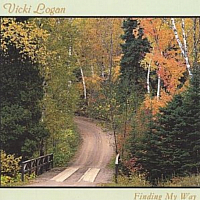 Vicki Logan’s second album titled Finding My Way on her Carvic label achieved a top 100 album rating, airing on over 700 online radio stations worldwide. The song Enchanted Winds did arrive at a top # 1 song in AOL Radio for an astounding 21 weeks, reaching the final destination with high ratings.
Vicki Logan’s second album titled Finding My Way on her Carvic label achieved a top 100 album rating, airing on over 700 online radio stations worldwide. The song Enchanted Winds did arrive at a top # 1 song in AOL Radio for an astounding 21 weeks, reaching the final destination with high ratings.
Charting a course as a new musician has never been easy for any artist and by no fault of her own, Vicki has had her share of unforeseen detours and roadblocks along the way, but her professional drive and spirited ambition has led the way to increasing popularity and recognition along her adventurous journey.
Finding My Way is the title Vicki chose for this album since it describes a representation or timeline of where Vicki felt she was in relation to her music career. With that said, her timeless New Age classics have found their way to many people’s hearts and minds with the winning combination of solo performances of piano, flute, saxophone, and guitar along side synthesized representations.
The song Pegasus reveals the exhilarating flight of a mythological horse free, unbridled, and floating weightless during the ride of a lifetime of chasing dreams, gently leaving a trail of puffy white clouds in it’s wake. The bass percussion sprints ahead in tempo while piano melody vigorously runs through the scales in an inspirational message about undaunted courage. When Xylophone makes an impromptu entrance, it becomes pretty clear by the lively solo response that this winged horse desires freedom most, having made all the right moves to evade capture by any mere mortal.
My Mother’s Memories is a symbolic song tribute one can easily compare to a mother’s loving embrace. This hymn of love is shown through a classic piano movement complete with angelic choir vocals that emphasize the content of her character and humanity, clearly stated by the pronounced reverent atmosphere.
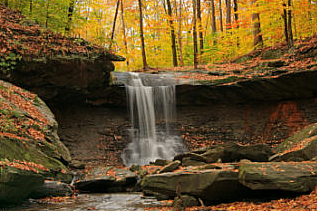 The emotional tale of a mother’s lifetime of memories is passionately recalled from one family generation to the next by a heart felt piano narration, where her praiseworthy commitment of giving becomes apparent while recalling the eventful past.
The emotional tale of a mother’s lifetime of memories is passionately recalled from one family generation to the next by a heart felt piano narration, where her praiseworthy commitment of giving becomes apparent while recalling the eventful past.
Then, almost as if waiting in respectful attention for the proper moment to arrive, something truly amazing happens.
In a heart felt solo performance, an all encompassing trumpet respectfully announces mother’s grand entrance onto the world stage in a proud anthem, as if honoring all deserving Mothers with a standing ovation of praise.
As if rising to the occasion during this profound moment of tribute and recognition, the choir validates through their own voice the unconditional love and support all caring Mothers around the world have given during their lifetime.
Discovering the positive and inspiring music of Vicki Logan and then writing about this New Age artist who is so passionate about their music has been personally rewarding. Having the opportunity to meet this friendly and outgoing musician by our recent interview together has been an honor.
Read my reviews of her 4 albums and our interview on my pages for Vicki Logan. Visit VickiLogan.com website and sample Vicki Logan’s CD albums at CDBaby. Picture copyright Big Stock Photo – Xmasbaby.
If you have already experienced the bright and talented music of Vicki Logan you know what I write today is solid truth. For anyone who has yet to discover her music, prepare yourself for a truly original New Age artist whose music is so unique one can compare her inspiring musical expression as unique to each person as an individual.
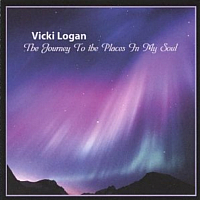 When I am not diligently listening to and writing another artist’s album on review, I regularly find myself returning to the music of Vicki Logan. After first discovering her inspirational New Age music expressions, everyone I have shared her music with loves her discography as well, so it is not just mere coincidence.
When I am not diligently listening to and writing another artist’s album on review, I regularly find myself returning to the music of Vicki Logan. After first discovering her inspirational New Age music expressions, everyone I have shared her music with loves her discography as well, so it is not just mere coincidence.
Vicki Logan’s latest release titled The Journey To the Places In My Soul, under her Carvic Publishing label, is the review we shall explore together. Come with me to find the inspirational bliss someone would expect to hear from a more globally recognized artist. First released in 2006, and now reissued in 2009, this album is upbeat classical in style, shape and form. This album has a palpable feeling of the artist’s personal creative touch and source of inspiration integrated into every song.
Track 2 The Journey is an upbeat inspirational flute and piano tune that will inspire and enlighten you today and everyday. Track 3 Dancing with the Northern Lights is a kaleidoscope of colors revealing every tone and shade of an Aurora Borealis. This is pretty colorful if you can imagine or have ever witnessed the northern lights.
The Journey To the Places In My Soul carries an abundance of depth and feeling in each of the melodies which leads me to believe much thought and a portion of the artist’s personality are on display in this latest project. This is true in prior albums also, where one can listen to over and over and still find a great album with the passage of time, being an important consideration when purchasing CD’s.
 There is also a complexity to her inspirational music described as deep, up tempo and orchestral, with wonderful instrumentals of piano, guitar, sax, oboe, and ever present flute which she plays with drive and purpose. To their credit, fellow band members add their own personal flavor by accompanying on individual songs which enhance the album’s classic theme admirably. On her releases she enlists the help of Randy Gildersleeve, Andy LaCasse, Peter O’Gorman, Matt Fink, and others to produce built with pride album every time.
There is also a complexity to her inspirational music described as deep, up tempo and orchestral, with wonderful instrumentals of piano, guitar, sax, oboe, and ever present flute which she plays with drive and purpose. To their credit, fellow band members add their own personal flavor by accompanying on individual songs which enhance the album’s classic theme admirably. On her releases she enlists the help of Randy Gildersleeve, Andy LaCasse, Peter O’Gorman, Matt Fink, and others to produce built with pride album every time.
Track 6 Everlasting Memories presents a flute and piano arrangement with additional guitar rhythms combining for a more mystical tone, yet still retains a hopeful theme as if recalling distant memories of years gone by.
The Journey To the Places In My Soul carries an abundance of depth and feeling in each of the melodies which leads me to believe much thought and even a portion of the artist’s personality are on display in this latest project. This is also true in prior albums, in which one can listen to over and over and still find meaningful and sounds great with the passage of time. When we first spoke, I informed Vicki Logan I am also one of her many fans. She just laughed and seemed surprised, which is just typical of Vicki, who is much too modest when discussing her talents in my opinion. I hope you will take the time to decide for yourself.
Vicki Logan and I have an interview planned, so more information and more album reviews are available to you so that you may discover what I have found in the inspiration music of this uniquely bright star known as Vicky Logan.
Visit VickiLogan.com homepage. Sample at CDBaby and read my pages for Vicki Logan. Big Stock Photo – Wilmy.
